The Industrial Revolution is one of the greatest turning points in human history, reshaping the entire economy, society, and civilization. From the first steam-powered machines in 18th-century Britain to today’s era of artificial intelligence, the successive industrial revolutions have continuously driven extraordinary advances in labor productivity, manufacturing technology, and the way humans interact with the world.
More than just a change in production methods, each industrial revolution has ushered in a new era—one in which humanity must adapt, innovate, and transform to avoid being left behind. As the world moves deeper into the Fourth Industrial Revolution, understanding the historical development, nature, and impacts of these transformations is essential for both businesses and individuals to shape their future strategies.
However, it is important to note that the term “industrial revolution”—like many historical concepts—is more convenient than strictly accurate. It provides a helpful framework for research and education, especially given that the transition between the 18th and 19th centuries saw numerous groundbreaking innovations that justify identifying a distinct historical period. Yet in reality, the process of industrialization has no clearly defined beginning or end. Suggesting it was a one-time shift from a pre-industrial to a post-industrial society can be misleading, as the technological, commercial, and manufacturing foundations were laid over centuries and continue to evolve to this day.
Therefore, when using the term “industrial revolution,” a flexible and cautious perspective is required. In the context of this article, we will use the term to describe the explosive growth in innovation and productivity, particularly during the first 150 years, while treating developments from the 20th century onward as a critical transitional phase.
This article will guide you through the journey of the four industrial revolutions—from steam power, electricity, and computing to artificial intelligence—and highlight the groundbreaking changes they have brought about. It will also introduce smart robotic solutions in modern manufacturing, with a case study of Rozitek—a pioneer in factory automation that provides intralogistics robot systems, management software, and comprehensive integration with existing production lines.
Overview of the History of the 4 Industrial Revolutions
The development of human history has gone through four industrial revolutions, each closely associated with groundbreaking inventions that radically transformed production methods, social structures, and lifestyles. From steam-powered mechanization to the era of artificial intelligence, the following is a comprehensive overview of the world’s industrial transformation journey.
1. The First Industrial Revolution (1.0): Steam-Powered Mechanization
The First Industrial Revolution, also known as Industrial Revolution 1.0, took place from the late 18th to the mid-19th century, originating in England – the cradle of many revolutionary inventions in manufacturing and mechanical engineering. It marked a significant turning point, transitioning traditional agricultural economies to large-scale industrial production powered by steam engines.
Between 1760 and 1830, this revolution was primarily confined to England. The British government at the time even banned the export of machinery and engineering expertise to protect its monopolistic advantage. However, these barriers couldn’t prevent the spread of knowledge and technology: other European countries soon began to adopt and develop industrial advancements, with Belgium being the first in continental Europe, followed by France, Germany, the US, Japan, and others—all entering the industrialization race.
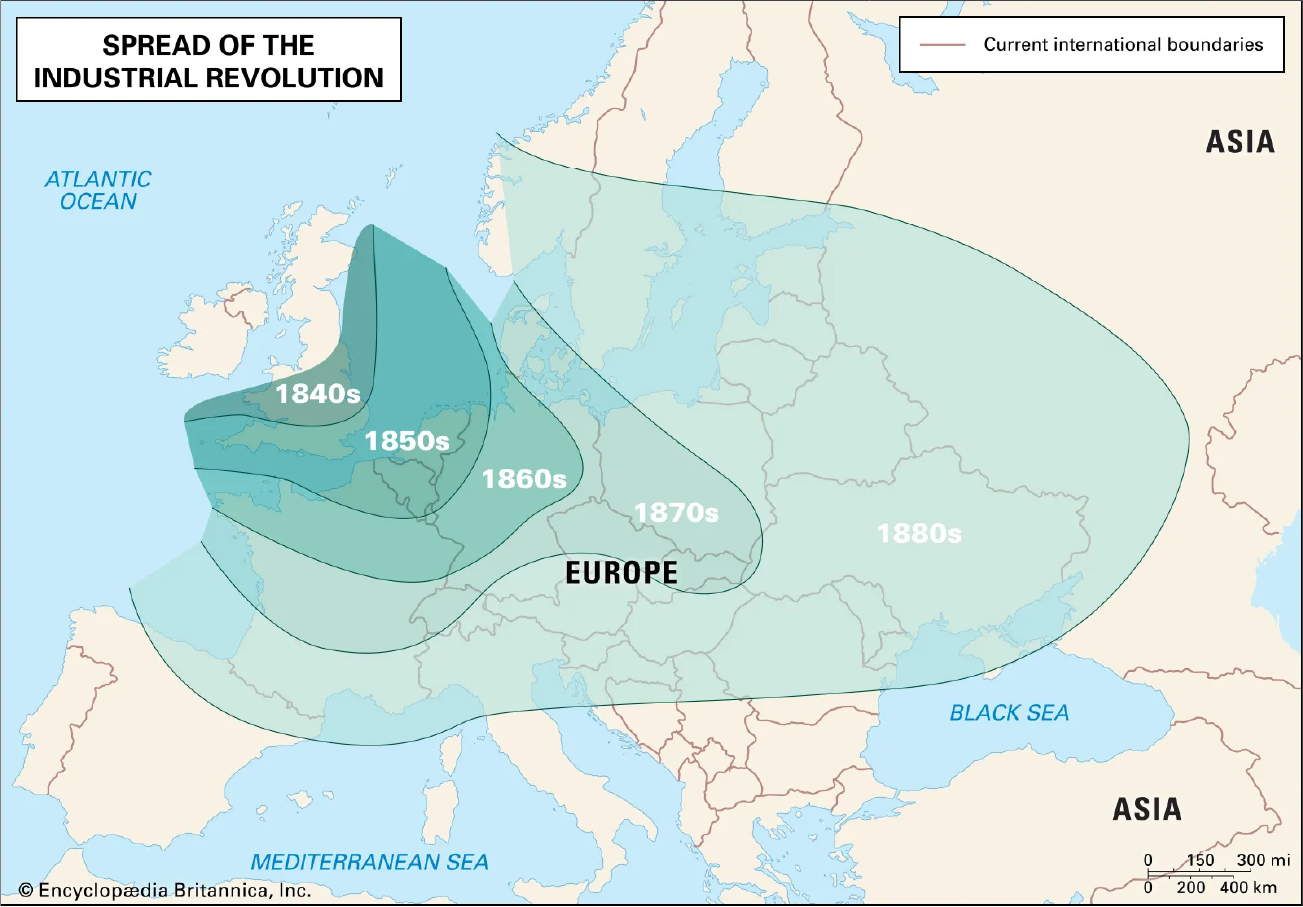
Map illustrating the spread of the Industrial Revolution across Europe in the 19th century.
Source: https://www.britannica.com/
Before this revolution, most goods were handcrafted at home or in small workshops with low productivity and a heavy reliance on human labor. The invention and improvement of the steam engine by James Watt in 1776 ushered in a new era: machines could replace human effort in many stages of production, especially in key industries such as textiles, metallurgy, and mining.
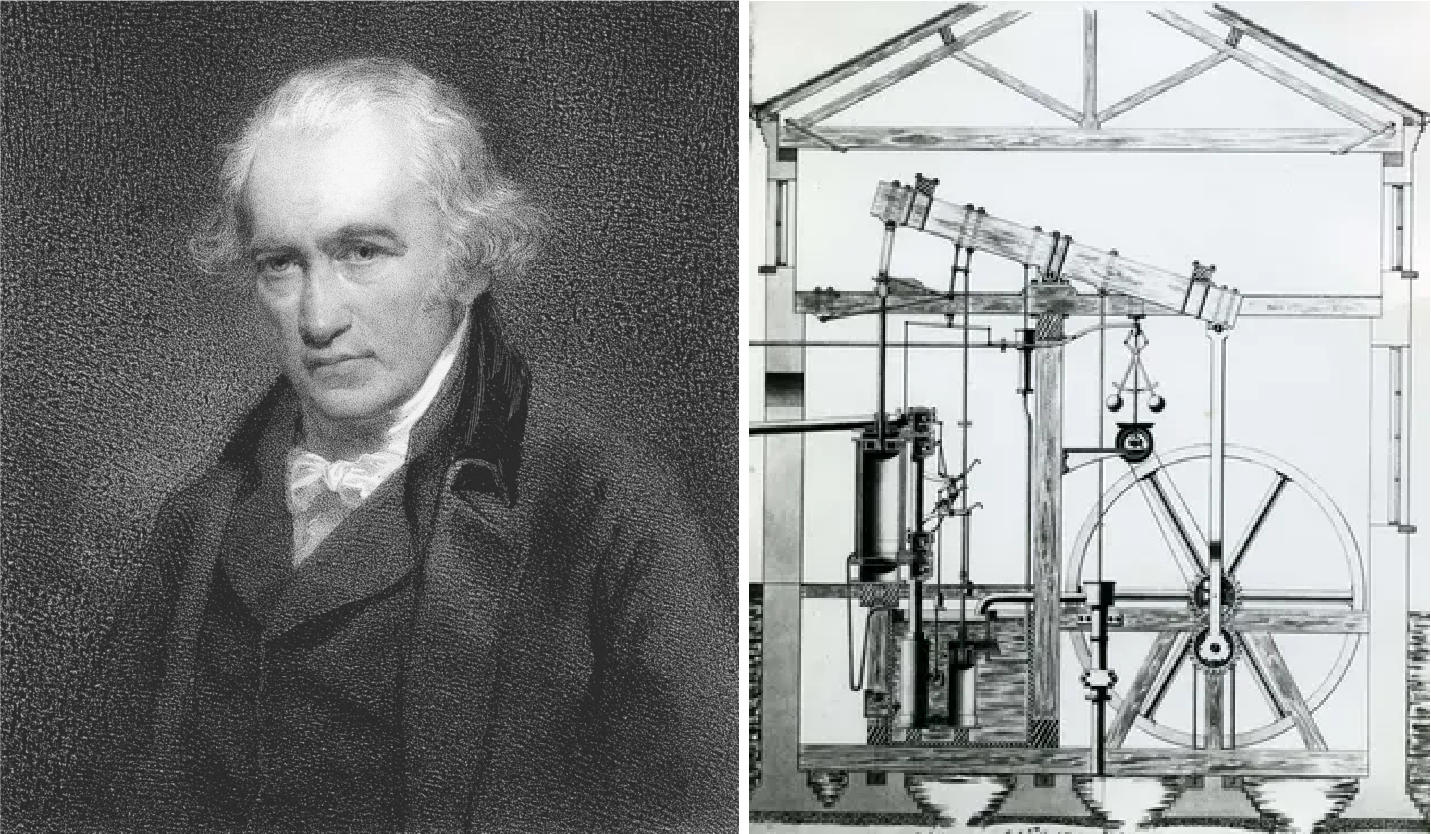
Portrait of James Watt and Watt’s Rotative Steam Engine:
Original 1788 drawing of the rotative steam engine designed by James Watt, utilizing a sun-and-planet gear system; currently on display at the Science Museum in London.
Source: https://www.britannica.com/biography/James-Watt
A series of other inventions also helped shape Industrial Revolution 1.0, such as:
The Spinning Jenny (1764), which boosted yarn production.
The water frame, which used water power to operate looms.
Coke-based iron smelting, which replaced charcoal and made metal production more efficient.
One of the most notable outcomes of Industrial Revolution 1.0 was the emergence of centralized manufacturing plants, replacing the dispersed, family-based workshop model. Factory workers operated in shifts and assembly lines, leading to the rise of the working class – a new social force that played a vital role in the 19th and early 20th centuries.
In addition, the revolution also accelerated:
Urbanization, as rural residents migrated to cities in search of factory jobs.
Infrastructure development, especially railways and canals to transport industrial goods.
Social restructuring, with the industrial bourgeoisie gradually becoming the central economic class, replacing the feudal aristocracy.
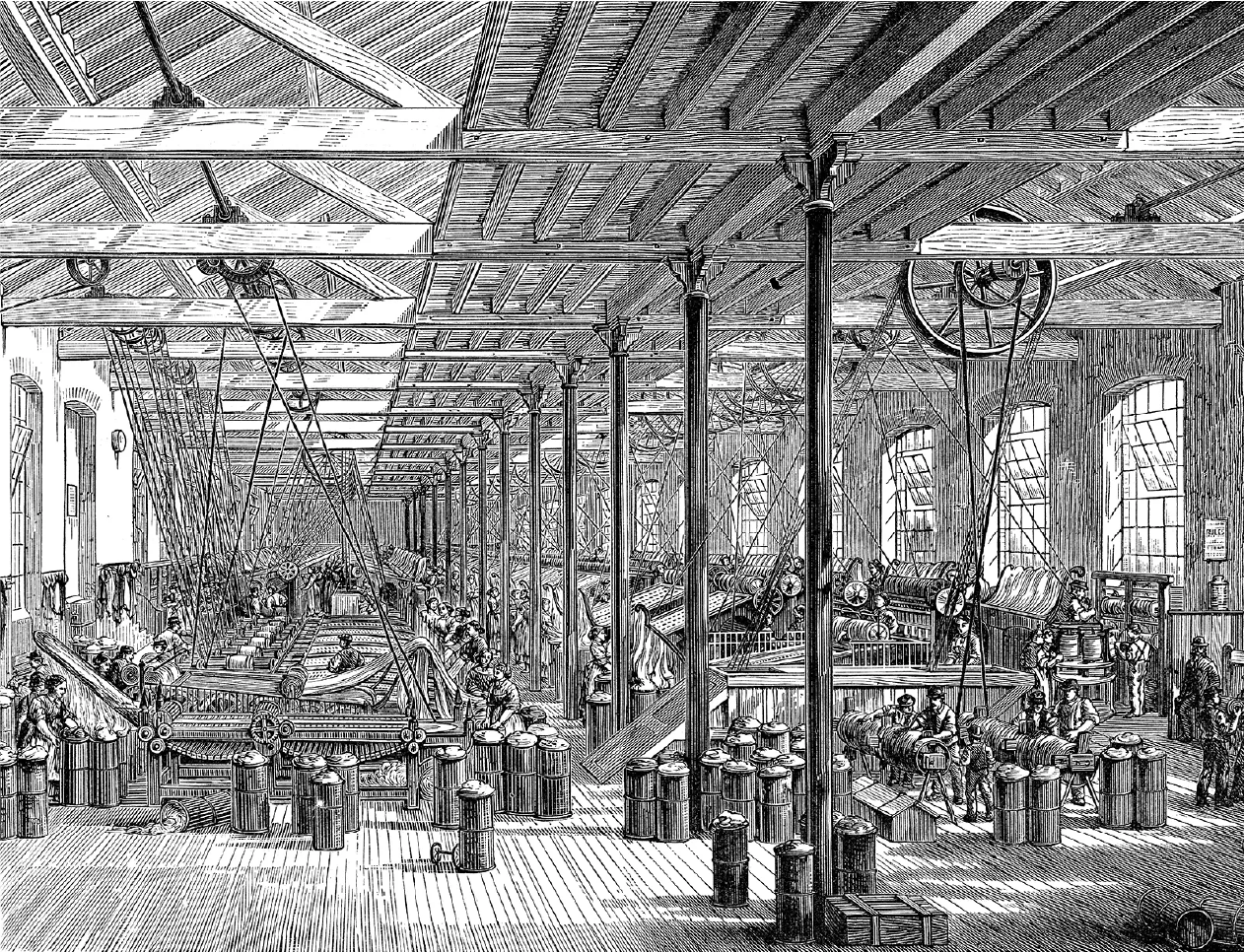
Industrial Revolution: Spinning Room –
Vintage engraving depicting the factory floor of the spinning room at Shadwell Rope Works, 1878.
Source: https://www.britannica.com/technology/history-of-technology/Technology-and-education
However, alongside great progress, the First Industrial Revolution also brought numerous downsides: harsh labor conditions, long hours, low wages, and even the use of child labor in toxic environments. These issues laid the foundation for labor union movements and struggles for workers’ rights in subsequent centuries.
In summary, Industrial Revolution 1.0 was the starting point of global modernization, laying the groundwork for subsequent revolutions and ushering in an era of industrialization, mechanization, and extraordinary productivity.
2. The Second Industrial Revolution (2.0): Electricity and Mass Production
The Second Industrial Revolution, also known as Industrial Revolution 2.0, took place from the late 19th to early 20th century, primarily in leading industrial countries such as the UK, US, Germany, and France.
While Industrial Revolution 1.0 focused on steam-powered mechanization, the hallmark of Industrial Revolution 2.0 was the application of electricity, internal combustion engines, and assembly line production – ushering in an era of mass production with superior productivity.
Electricity became the central power source, replacing steam with its greater flexibility, higher output, and transmission capability. Thanks to the invention and commercialization of the light bulb by Thomas Edison, along with advances in electric motors and generators, the industrial world entered a new era. Factories no longer had to be near rivers or dependent on steam; electric power enabled flexible and efficient production layouts.
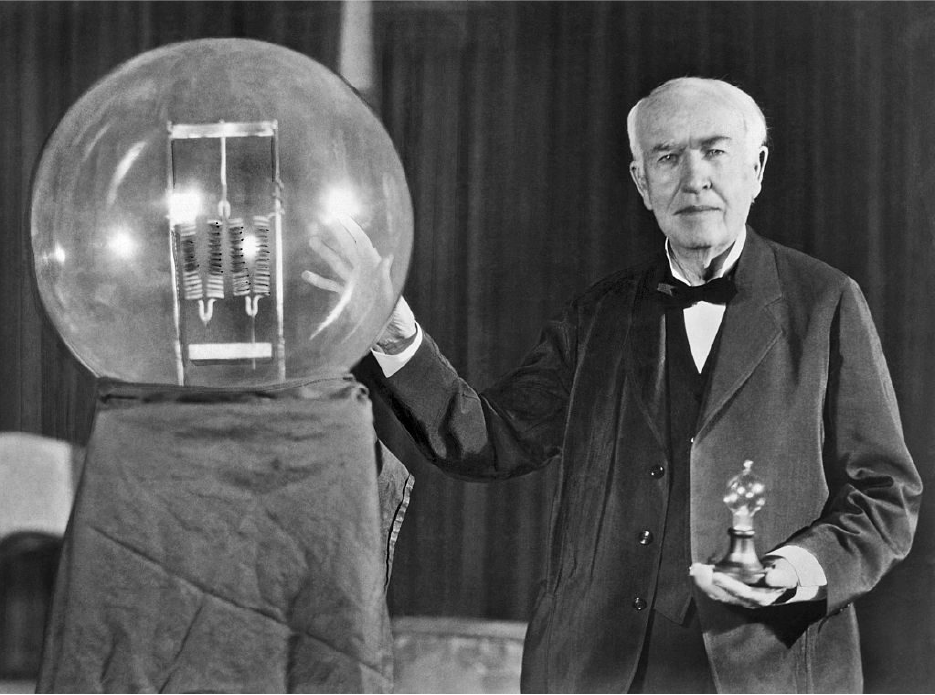
Portrait of Thomas Edison.
Source: https://www.pbs.org/newshour/health/the-medical-mystery-that-helped-make-thomas-edison-an-inventor
Alongside electricity, the internal combustion engine using oil was born and sparked a transportation and logistics revolution. Cars, ships, and later airplanes became widespread, quickly connecting regions and countries, boosting trade and expanding global markets.
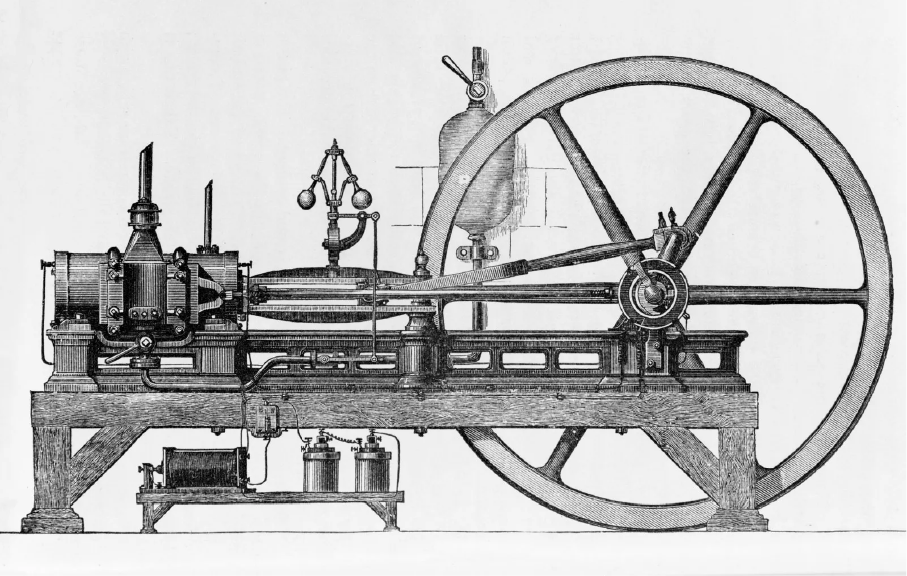
Internal Combustion Engine:
Illustration of a three-horsepower internal combustion engine using coal gas and air as fuel, 1896.
Source: https://www.britannica.com/list/inventors-and-inventions-of-the-industrial-revolution
One of the great advancements of Industrial Revolution 2.0 was the adoption of the assembly line, exemplified by Henry Ford‘s automotive production model in the U.S. Based on principles of “division of specialized labor” and automated assembly processes, Ford significantly reduced production time and costs, making cars affordable to the masses instead of only the elite.

Ford Motor Company Assembly Line:
Mass-production assembly line for manufacturing automobiles.
Source: https://www.thoughtco.com/henry-ford-and-the-assembly-line-1779201
The influence of Industrial Revolution 2.0 spread across all aspects of life:
In industry, factories were organized more scientifically and adopted assembly line management, increasing productivity many times over.
In transportation, modern railways, cars, and ships expanded global logistics networks.
In communication, the emergence of telephones, telegraphs, and wireless signals allowed real-time connection across distant areas.
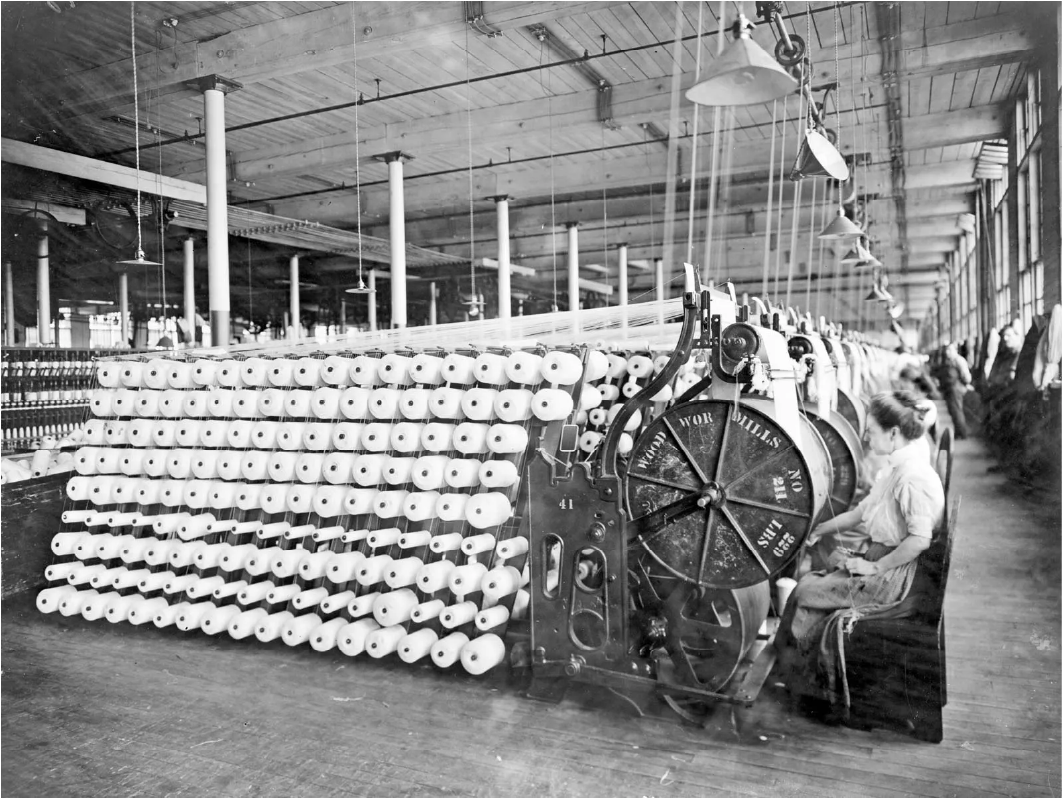
Industrial Revolution: Factory Workers –
Women operating machinery at the American Woolen Company, Boston, circa 1912.
Source: https://www.britannica.com/event/Industrial-Revolution/The-first-Industrial-Revolution#ref3504
This period also saw the rise of many new industries, such as chemicals (fertilizers, dyes, synthetic plastics), steel, oil refining, and machine manufacturing. This marked the global economy’s entry into rapid industrial development and laid the groundwork for modern industrial powers.
However, rapid growth also brought negative impacts: overexploitation of resources, rising inequality, and poor working conditions. These prompted union movements, labor reforms, and legal protections for workers.
In summary, the Second Industrial Revolution brought the world into an era of mass production, full-scale industrialization, and global economic integration, forming the foundation of today’s modern society.
3.Third Industrial Revolution (3.0): Digital Technology and Early Automation
The Third Industrial Revolution, also known as Industry 3.0 or the Digital Revolution, began in the late 1960s and continued through the late 20th century. Unlike the first two revolutions, which relied on mechanical and electrical energy, Industry 3.0 was powered by electronics, information technology, and production automation using computers.
Its core was the emergence and widespread use of computers, processors, integrated circuits (ICs), and programmable logic controllers (PLCs). These innovations enabled precise, fast, and continuous machine operation without manual intervention—paving the way for automated production and digital data management.
Key technologies of Industry 3.0 included:
Personal computers (PCs) and software for production and office use;
Industrial robots, first used in automotive, electronics, and packaging industries;
CNC systems (Computer Numerical Control) for programmable machine control;
Computer networks, especially the Internet from the late 20th century, enabling real-time global information transmission.
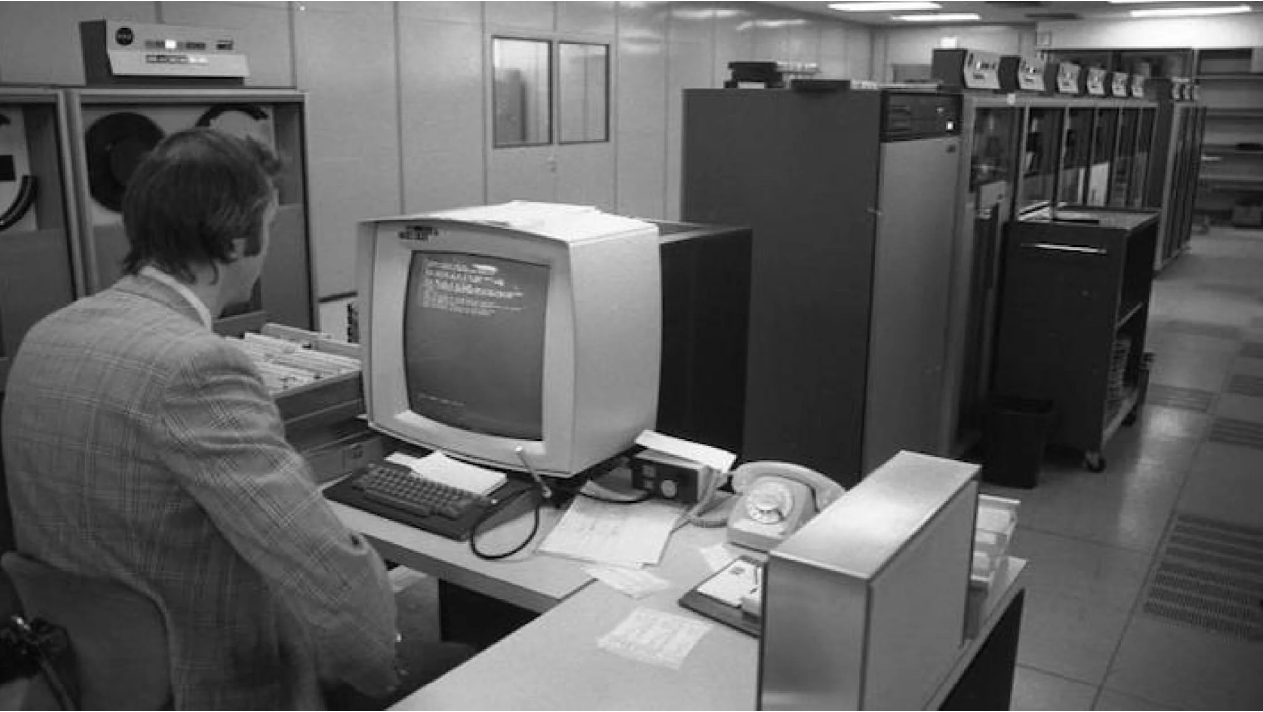
Industry 3.0 focused on digital technologies.
Source: https://cepr.org/voxeu/blogs-and-reviews/globalisation-automation-and-history-work-looking-back-understand-future
The most obvious impact of Industry 3.0 was basic process automation—manual operations were gradually replaced by automatically controlled machines. This allowed businesses to:
Increase product accuracy and stability;
Reduce labor costs and human error risks;
Improve management efficiency using ERP, MES, SCM software…
Beyond manufacturing, Industry 3.0 also influenced areas such as:
E-commerce (emerging in the late 20th century);
Financial services, with digital banking systems;
Education and communication via computers and the Internet.
However, Industry 3.0 also introduced challenges: machines replaced low-skilled labor, increasing unemployment in some sectors, while digital skills and thinking became more critical than ever. Issues such as data security and technological inequality among nations also emerged.
In conclusion, the Third Industrial Revolution digitized production and management, bringing the world closer to a knowledge-based economy and laying the groundwork for the Fourth Industrial Revolution.
4. The Fourth Industrial Revolution (4.0): Artificial Intelligence and the Internet of Things
The Fourth Industrial Revolution – also known as Industry 4.0 – is a revolution that has been strongly unfolding across the globe since the early 21st century. Unlike previous revolutions that focused on a single technological field, Industry 4.0 is the convergence and integration of multiple fields such as physics, digital technology, and biology, laying the foundation for a completely new production and consumption ecosystem that is smart, connected, and autonomous.
The core components of Industry 4.0 include:
Artificial Intelligence (AI): enables machines to learn and make decisions without needing detailed step-by-step programming;
Internet of Things (IoT): all devices, sensors, and machinery are connected and share data with each other;
Big Data: collects, analyzes, and predicts production and consumption behaviors on an unprecedented scale;
Cloud Computing: stores and processes information quickly from anywhere;
Smart Robots and 3D Printing: expand personalization and change traditional production processes;
Blockchain: enhances transparency in supply chains, contracts, and product traceability.

Industry 4.0: Intelligent robotic systems transporting goods inside Rozitek’s factory.
The key distinction of Industry 4.0 is not in merely “replacing humans with machines,” but rather in creating self-optimizing, self-learning, and self-connected production systems. Today’s “smart factories” can operate with minimal human intervention, yet achieve significantly higher efficiency and precision. Production becomes flexible, easily meeting personalized demands while also reducing costs and resource usage.
The impact of Industry 4.0 goes far beyond factories:
In business, management shifts to real-time data-driven decision-making;
In economy, new models emerge like digital economy, sharing economy, e-commerce, and digital supply chains;
In education, digital skills training, online learning, and AI-assisted teaching;
In healthcare, AI is used in image diagnosis, surgical robots, and electronic health records;
In daily life, smart homes, self-driving cars, customer-supporting chatbots, etc.
However, alongside its huge potential, Industry 4.0 also poses many challenges:
Risk of job loss for workers who lack retraining;
Digital inequality between regions, businesses, and individuals without access to technology;
Cybersecurity and privacy become crucial concerns;
Digital transformation pressure makes it difficult for small and medium enterprises to keep up.
In summary, the Fourth Industrial Revolution is a monumental step forward that transitions the world from traditional automation to smart automation, and from human-to-human connection to the Internet of Everything. In this context, businesses that lead in applying new technologies—especially in the fields of robots, AI, and automation—will be the ones that shape the future.
Impacts of Industrial Revolutions on Modern Life
From the First Industrial Revolution with steam power to the Fourth Industrial Revolution driven by artificial intelligence and big data, humanity has witnessed sweeping transformation in every dimension: production, goods distribution, organizational operations, and personal life. Each industrial revolution has not only propelled economic growth but also reshaped how we work, communicate, and live day to day.
Below are the major ways the industrial revolutions have affected modern life:
1. Production: From Handcrafted to Smart
Industrial revolutions have continuously improved productivity and production efficiency. From using steam engines in early factories to automated production lines controlled by AI today, products are now made with consistent quality, higher speed, and lower costs.
Currently, factories not only operate automatically but also have the ability to learn and optimize processes through big data and IoT connections. The shift from mass production to mass customization has become a reality.
2. Employment and Workforce: Changing Skills – Changing Mindset
Every industrial revolution has created waves of new occupations while rendering others obsolete. From textile workers and craftsmen to robot technicians, AI programmers, and data specialists—the workforce has had to continually learn, upgrade digital skills, and adapt to technology.
In Industry 4.0, the ability to use digital tools, think critically, innovate, and collaborate with smart machines is becoming a core life skill. Remote work, freelancing, and the gig economy are increasingly common, breaking the traditional structure of labor markets.
3. Economy and Business Models: From Ownership to Connectivity
The industrial revolution has opened up globalized business models. With advancements in digital technology and the internet, businesses can now sell, operate, and manage across borders with ease.
Traditional business models are being replaced or upgraded through e-commerce, sharing economy, on-demand services, and digitally integrated supply chains. Data has shifted from being a by-product to becoming a strategic asset, helping businesses make faster and more accurate decisions.
4. Personal and Social Life: Connected – Smart – Convenient
Modern personal lives are closely tied to industrial products:
Homes have become smart homes, controllable via smartphones.
Shopping, payments, learning, and working can be done online anytime, anywhere.
AI and chatbots provide 24/7 customer support.
Self-driving cars, smart wearables, and helper robots are no longer science fiction.
Moreover, the way people communicate and share information has changed dramatically – from letters and landline phones to social networks, video calls, and the metaverse – creating a prominent virtual living space.
5. Environment and Sustainability: Dual Impacts
Industrial revolutions have both caused pollution, climate change, and resource depletion and driven the development of green technologies and sustainable solutions.
Today, robots and AI are used to monitor the environment, optimize energy use, and design production processes that cut emissions and conserve resources. At the same time, growing awareness of social responsibility and planetary stewardship is becoming central to modern corporate strategy.
In short: Industrial revolutions have done more than grow economies—they have reorganized human life. In an era of digital transformation and Industry 4.0, recognizing these impacts helps individuals, organizations, and nations prepare for a more dynamic and sustainable future.
The Future: Industry 5.0?
Industry 5.0 is the next stage after Industry 4.0, with a core shift: putting humans back at the center of production. Rather than optimizing solely through technology, Industry 5.0 emphasizes collaboration between humans and robots to create personalized, creative, and higher-value products.
Unlike the fully automated robots of Industry 4.0, collaborative robots (cobots) in Industry 5.0 work safely alongside people, assisting in tasks that demand dexterity, judgment, emotion, or human-centered decisions. This era also underscores sustainability, cutting waste and using resources more efficiently.
With a rapidly advancing technology base, Vietnam has a major opportunity to embrace Industry 5.0—especially in manufacturing, logistics, and automation. Success will require investment in education, new skills, innovation, and partnerships. Forward-leaning companies such as Rozitek, which blend technology, automation, and human expertise, are well positioned to help build smart production ecosystems.
Robots in Industry 4.0 and Rozitek’s Solutions
As Industry 4.0 spreads worldwide, intelligent industrial robots play a critical role in advancing automation and improving production efficiency. Unlike traditional robots that simply repeat programmed actions, 4.0-era robots integrate artificial intelligence (AI), machine vision, and IoT connectivity, allowing them to learn, make decisions, and coordinate flexibly with other factory systems.
Today’s smart robots do more than assemble, package, or transport—they communicate with manufacturing execution systems (MES) and plant control platforms, enabling synchronized workflows, optimization, and real-time monitoring. As a result, companies can reduce labor, improve accuracy, shorten production cycles, and enhance product quality.
Rozitek's Solution: Smart automated transport within the factory
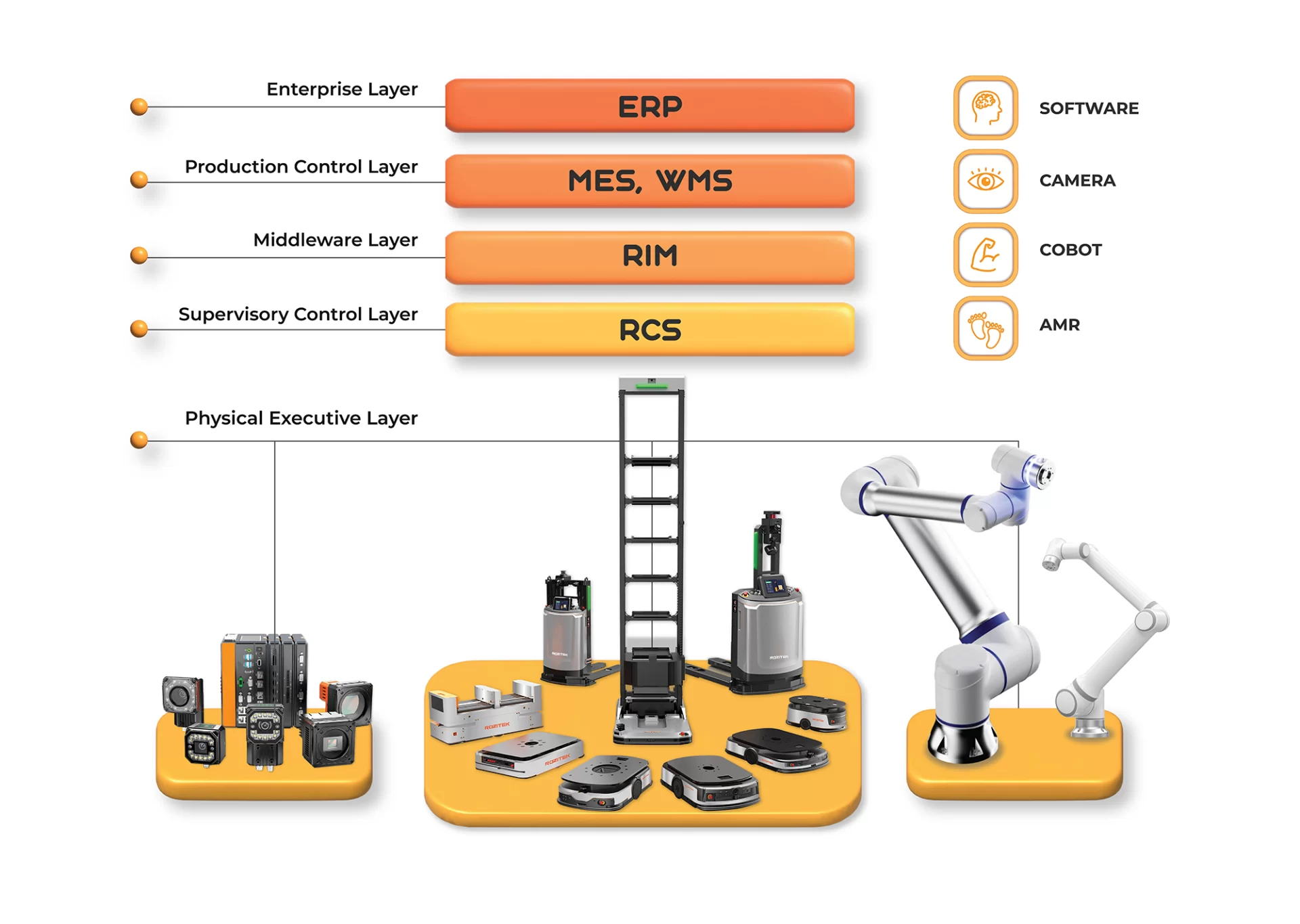
Grasping the trend, Rozitek – a technology company specializing in automation – brings comprehensive intralogistics solutions for manufacturing plants in the Industry 4.0 era.
Rozitek’s solution includes 3 main components:
Helps manage goods flow, processing time, storage locations, and connects directly with ERP systems/production lines of the enterprise.
Robots are designed to transport raw materials, semi-finished or finished goods between areas in the factory in a flexible, safe, and optimized way. With positioning capabilities, obstacle avoidance, and integration of smart sensor systems, Rozitek’s robots operate efficiently in constantly changing environments.
- Integrated System Capabilities
Rozitek’s experienced team is capable of providing consulting – design – implementation – operation and maintenance of automation systems, ensuring smooth integration with existing production lines without disrupting operations.
Industry 4.0 is no longer just a future trend but is happening now. Investing in smart robot solutions and automation systems like those provided by Rozitek helps businesses not only keep pace but also lead the digital transformation and global competition.
Are you ready to transform your factory into a smart production facility?
Rozitek is ready to accompany you in the transformation journey – from strategic consulting, robot deployment to the completion of intralogistics systems.
Contact us today to receive free consulting and customized solutions tailored to your business needs.
